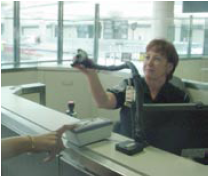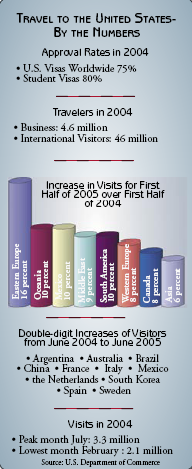

My name is Kathleen Faws. I am a Customs and Border Protection Officer (CBPO) for the Port of Washington at Washington Dulles International Airport outside of Washington, D.C.
On any given day, I see between 200 and 300 passengers, from all walks of life, many with interesting backgrounds and reasons for visiting the United States.
Among the questions I ask all passengers is the purpose of their trip. I have met many parents coming to visit children who are either studying at U.S. schools or who have moved permanently to the United States and now have children of their own.
One couple I met was coming to visit their son who was studying at a university. When I asked how long their visit would be, they answered that it would be about two weeks. Then the woman smiled and said that it would be two weeks—unless their son sent them home sooner. As a parent myself, I understood exactly what she meant and we shared a laugh at our common experience.
Another passenger was coming here from Great Brit¬ain to visit some U.S. citizens who are veterans of World War II. When he was a boy, these men crashed their military plane on his parents’ farm in England. Over the years, he said, most of their reunions had taken place back at his family farm, but now it was getting harder for the aging veterans to travel, so he was making the trip to the United States for their reunion.
I especially enjoy talking to children who are coming to the United States for the first time. If they are coming to visit the sights in the Washington, D.C., area, I like to know what, in particular, they are most eager to see. One little boy told me that he wanted to go to the Air and Space Museum. After a few moments, he offered that his little sister wanted to see Toys-R-Us.
While it is a pleasure to meet so many people from such diverse backgrounds, it is the mission of the CBP officers to be guardians of America’s borders. We are the front line, and it is our responsibility to enforce the laws of the United States and protect the American public against terrorists and the instruments of terror.
Here at the Port of Washington, we serve approxi¬mately 42 international flights per day with passengers coming from all corners of the world. It is our responsi¬bility to ensure that passengers have the proper documen¬tation, whether on a return or initial visit to the United States. This task must be accomplished relatively quickly, since a lot of passengers arrive at the same time and many may have connecting flights.
We must decide in a short period of time that the passenger is who he or she claims to be, has the proper documentation, and is not here in the United States to do harm to our country, either physically or economically.
The new security procedures we now have in place help with that. We check passports, photos, and visas against several databases to make sure they haven’t been stolen or altered, rapidly scan and compare a passenger’s digital fingerprints, and conduct a brief conversation to determine entry eligibility.
Most current travelers have heard of the US-VISIT (United States Visitor and Immigration Status Indicator Technology) program, which was put in place to enhance the security of both American citizens and our visitors, make legitimate international travel and trade go more smoothly, ensure the integrity of our immigration system, and protect the privacy of our visitors.
As a general rule, we complete a US-VISIT transaction for all visitors between the ages of 14 and 79. This includes a fingerprint reading by a digital scanner for both the right and left index fingers and taking a photograph. It is a very quick process that adds minimal time to the inspection process. Travelers have rapidly become accustomed to the procedure, and most understand that it is an important security measure. Normally, the only passengers who express unhappiness with the procedure are the children under 14 who are disappointed not to have their own fingerprints and photograph taken. It must look like fun to them.
All customs and border protection officers hold a tremendous responsibility in being able to grant or deny entry into the United States, as well as being the first per- sons to greet legitimate travelers. We take pride in doing our job well.




















